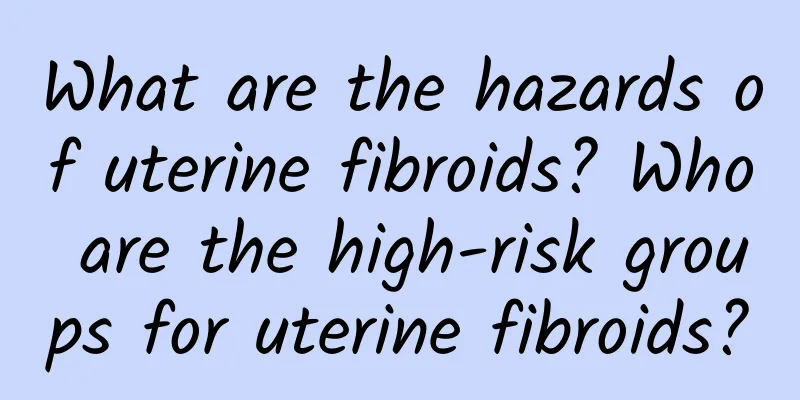What are the hazards of uterine fibroids? Who are the high-risk groups for uterine fibroids?

|
Understanding of uterine fibroid surgery: uterine fibroids are benign tumors formed by the proliferation of uterine smooth muscle tissue. Common manifestations include uterine bleeding, pain, abdominal mass, compression symptoms of adjacent organs, increased leucorrhea, anemia, heart dysfunction, etc. Some patients have no symptoms and uterine fibroids are often found during gynecological examinations. Uterine fibroids are the most common benign gynecological tumors, which are more common in 30-50 years old. According to the different locations of uterine fibroids, they can be divided into intramural, subserosal, submucosal and intra-broad ligament fibroids. Surgical treatment of uterine fibroids: If the fibroids are small, asymptomatic, without complications and degeneration, generally no treatment is needed. Especially for people approaching menopause, due to the low estrogen level after menopause, the fibroids will naturally shrink or disappear, and only regular (3-6 months) review is required. If the fibroids are found to be enlarged or the symptoms are obvious, further treatment should be considered. 2. Surgical treatment: (i) Hysterectomy is suitable for hysterectomy of uterine size >3 months of pregnancy, although the fibroids are not large, but the symptoms are obvious, or the growth of fibroids cannot rule out malignancy; (ii) Myoma removal: Suitable for patients under 35 years old, unmarried or childless; 3. Drug treatment: It is used for patients with small fibroids, mild symptoms, near menopause or general condition that cannot tolerate uterine fibroid surgery. (a) methyltestosterone, testosterone propionate; (II) Progesterone. ① For patients who need to have children; ② Choose medroxyprogesterone acetate, megestrol acetate, norethindrone, etc.; ③ Luteinizing hormone-releasing hormone analogs. Prevention of uterine fibroid surgery: Patients with uterine fibroids should have regular checkups, such as ultrasound or gynecological examinations every 3 to 6 months. If older women experience rapid growth of fibroids in a short period of time or vaginal bleeding after menopause, they should be alert to sarcoma degeneration. People with heavy menstruation should actively correct anemia and prevent anemic heart disease and myocardial degeneration. Troubles after surgical removal The lowest level method to completely cure uterine fibroids is total hysterectomy. However, after hysterectomy, patients will lose their fertility, and a small number of patients may also experience decreased ovarian function or mental disorders, which directly affects the quality of life. Therefore, for patients who want to maintain their fertility and need to keep their uterus, doctors will agree to use simple myomectomy after weighing the pros and cons. However, simple myomectomy does not mean getting rid of the trouble of fibroids, and some patients may still experience recurrence of fibroids. The recurrence rate after uterine fibroid surgery is high, generally 20%-30%. Some studies believe that the recurrence rate can reach 50%. The main reasons for the recurrence of fibroids are as follows. First, although the fibroids have been removed, the pathogenic factors of the fibroids still exist, and new fibroids appear a few years after surgery. Secondly, during myomectomy, the doctor finds the fibroids and removes them based on the abnormal appearance and tactile sensation of the uterus. Therefore, there may still be smaller intramural fibroids, which gradually grow under the action of ovarian sex hormones after surgery. According to statistics, in menopausal women, as the time after surgery gradually increases, the recurrence rate of fibroids also gradually increases. Generally, recurrence occurs 2-3 years after surgery, and recurrent fibroids are often more, that is, multiple fibroids. Early recurrence of uterine fibroids after surgery generally does not cause obvious discomfort and is often difficult to detect until menstrual changes or compression symptoms are seen in the hospital for examination. The fibroids are often very large. Clinically, it has also been confirmed that most patients who can detect the recurrence of uterine fibroids early have no clinical symptoms, but are discovered by regular B-ultrasound examinations in accordance with the doctor's instructions after surgery. Therefore, for patients who have undergone myomectomy, it cannot be assumed that the fibroids have been cured and that they can relax from now on, but they should be reviewed regularly, generally once every three to six months with a B-ultrasound examination. |
Recommend
What are the causes of mild cervical erosion? 3 symptoms of mild cervical erosion in women
Mild cervical erosion is a common gynecological d...
Successful pregnancy with Bartholinitis
Nowadays, Bartholinitis has gradually become a co...
Will a hysterectomy cause pelvic inflammatory disease?
Will a hysterectomy cause pelvic inflammatory dis...
What should you pay attention to in preventing cervicitis?
Cervicitis is a common gynecological disease. The...
What foods are good for menopausal women?
Menopause is a transition period from the vigorou...
What are the common causes of cervicitis?
Cervicitis is a common gynecological disease amon...
Surgical treatment of congenital absence of vagina
Patients with congenital absence of vagina suffer...
Check out the five major categories of female cervicitis. Women need to do four tests to diagnose cervicitis.
Cervical erosion is the most common type of chron...
Detailed explanation of the symptoms of severe cervicitis
The early symptoms of cervicitis are often ignore...
What are the dangers of hyperprolactinemia?
Hyperprolactinemia must be treated early to avoid...
What Chinese medicine should I take for a 6 cm uterine fibroid? Can a 6 cm uterine fibroid be treated with minimally invasive surgery?
What Chinese medicine should I take for a 6 cm ut...
What should be paid attention to in the treatment of endometrial tuberculosis
Endometrial tuberculosis is a common disease that...
How long after medical abortion can I have sex? What are the precautions after medical abortion?
Although some people take some contraceptive meas...
To prevent cataracts, you should eat a balanced diet and supplement riboflavin
As Taiwan's population ages, cataracts have b...
What is the difference between uterine fibroids and uterine hypertrophy? How to distinguish between uterine fibroids and uterine hypertrophy?
Uterine fibroids are a common female genital tumo...









